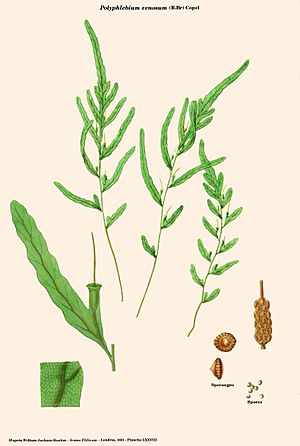Veined bristle-fern facts for kids
Quick facts for kids Veined bristle-fern |
|
|---|---|
 |
|
| Scientific classification | |
| Genus: |
Polyphlebium
|
| Species: |
venosum
|
| Synonyms | |
|
|
The Polyphlebium venosum, also known as the veined bristle-fern or bristle filmy fern, is a type of fern. It belongs to the Hymenophyllaceae family. This fern mostly grows in wet forests. You can often find it living on the shady side of soft tree ferns, like the Dicksonia antartica.
It also grows on logs, tree trunks, and sometimes on wet rocks. You can find this fern in the wetter parts of Eastern Australia and New Zealand. Polyphlebium venosum has spores that don't travel very far. This makes it harder for the fern to spread over long distances compared to other ferns.
Some special things about the veined bristle-fern are that it is only one cell thick. It can grow 5 to 15 centimeters long. It has many veins that branch out. Its spore cases, called indusia, are shaped like a trumpet.
Contents
What the Veined Bristle-Fern Looks Like
The adult fern stage, called the sporophyte, has thin, branching stems that creep along. These stems, called rhizomes, are covered with tiny, light brown hairs. The fern's leaves, known as fronds, are spaced out and hang down. They are 5 to 15 centimeters long. The fronds are delicate and you can almost see through them.
The main stem of the frond is very thin, like a thread. The leaf blade is light green, long, and narrow. It has an irregular shape and is simply lobed or divided into smaller parts. These smaller parts, called pinnae, can be very long. They sometimes hang almost straight down. The lower pinnae are often very small and far apart. The edges of the pinnae are wavy or slightly bumpy. The very end parts are blunt and wide, about 2 to 6 millimeters across. The veins in the frond are easy to see and branch many times.
The fern's spore cases, called sori, are found along the edges of the frond. They are tucked into short side lobes near the base of the pinna. Each sorus is shaped like a narrow trumpet and is 2 to 4 millimeters long. Inside, a fine stalk sticks out 10 millimeters or more.
The other stage of the fern's life, the gametophyte, is a branching thread. It has many small, stalked male parts called antheridia. Each antheridium has a simple wall that opens to let out the tiny swimming cells. The female parts, called archegonia, have straight necks. They are found on special structures.
How the Fern Got Its Name
This fern was first described in 1810 by Robert Brown. He named it Trichomanes venosum. Over time, scientists have changed how they group ferns. This means the name of the fern has changed a few times.
In 2016, a group of fern experts decided to place this fern in the Polyphlebium group. So, its name became P. venosum. It has also been called Crepidomanes venosum. However, some other plant databases still use the original name, Trichomanes venosum. This shows how scientists sometimes have different ideas about plant names!
Life Cycle and Where it Grows
The Polyphlebium venosum fern is only one cell thick. This means it can dry out very easily in hot or dry places. That's why it often grows in a mat on the shaded side of the Dicksonia antartica. This spot helps keep it moist and safe.
This fern is not in danger of disappearing worldwide. But big events like large wildfires can harm its populations. Because it relies so much on the Dicksonia antartica fern, it doesn't spread very far. Dry areas can act like barriers, stopping its spores from traveling.
Like other ferns, P. venosum has two main stages in its life cycle. These are the adult fern stage, called the sporophyte, and a tiny, flat stage called the gametophyte.
The adult fern (sporophyte) releases many tiny spores. These spores land on the trunks of D. antartica ferns, where it's moist and sheltered. The spores sprout in a few days. They grow into a thin, heart-shaped structure called a prothallus. It can take several months or even years for this prothallus to grow up.
The male parts, called antheridia, mature and release their swimming cells earlier than the female parts, called archegonia. This helps prevent the fern from fertilizing itself. The prothallus can also make new ferns without needing to combine cells. It does this by releasing tiny buds called gemmae. These gemmae can grow into new prothalli. The prothallus can also reproduce by simply growing new parts, which is called vegetative reproduction. Once the fern is settled, it spreads to nearby surfaces using its creeping rhizomes.
The spores of P. venosum sprout within two days after they are released. They can only survive for about 48 days on average. After two weeks, very few of the original spores are still alive. Most of the spores land very close to the parent fern. Because the spores don't live long, it's harder for P. venosum to spread over long distances compared to other ferns.
Where to Find the Veined Bristle-Fern
You can only find Polyphlebium venosum in wet forests. It grows in parts of Australia and New Zealand. In Australia, it is found in the Eastern states. These include Tasmania, Victoria, New South Wales, and Queensland.
Images for kids


